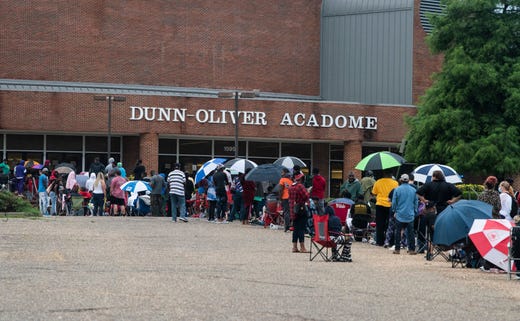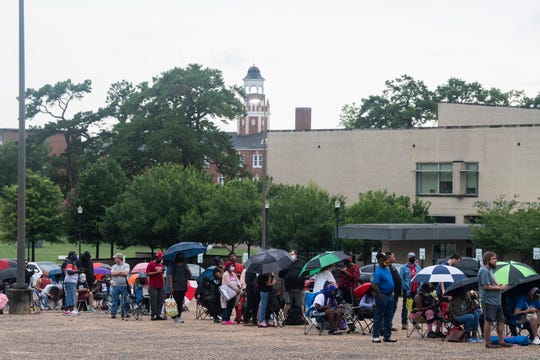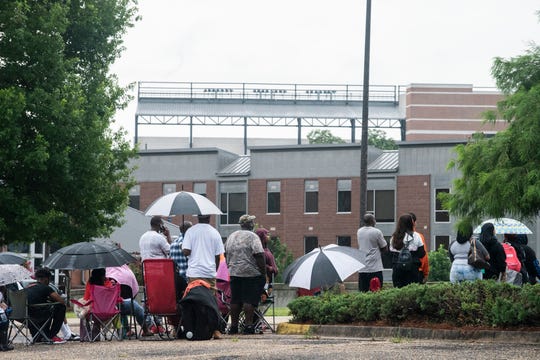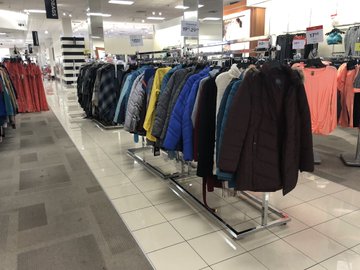Alabama may have to turn to the federal government to shore up its unemployment fund within 2 months. Meanwhile people wait in line overnight for help.
www.montgomeryadvertiser.com
As Alabamians sleep on pavement for benefits, state unemployment fund runs low
Melissa Brown, Montgomery AdvertiserPublished 3:26 p.m. CT June 26, 2020 | Updated 11:30 p.m. CT June 29, 2020
The Montgomery sky over the Alabama State University campus was rapidly developing from twilight blue to dusky navy when the rain began to fall on the two women.
The two pulled tote bags from their sedan before one shrugged into a yellow rain coat, stuffing her pockets with last-minute essentials. After one woman slung a folding chair over her shoulder, the two began their way toward the ASU Acadome, their heads bowed against a now-driving rain.
It was 8:30 p.m., and they were preparing to set up camp outside of Alabama's makeshift unemployment claims help center. It would be 12 hours until doors opened, and the two women weren't even the first in line when they arrived on the rainy Wednesday evening.
A line of unemployed or underemployed Alabamians has formed in Montgomery parking lots for weeks, first at the Cramton Bowl and later at the ASU Acadome, with thousands of people huddling through the night in hopes of receiving their version of a Golden Ticket: a numbered spot in line to speak to one of a handful of Alabama Department of Labor employees in person.
For many, it’s a last-ditch to receive unemployment benefits when phone call lines remain jammed, benefits are frozen for obscure reason and savings run out, if they existed in the first place. Amid an unprecedented global pandemic, many Alabamians can't afford to lose the maximum $275 Alabama unemployment weekly benefit, or the $600 CARES federal subsidy that will end next month.
The Alabama Department of Labor has been, by all accounts, overwhelmed. The department has received 576,314 unemployment claims to date. The department is staffed enough to field less than 4% of the calls it receives per day, according to department estimates, and staff trained to legally handle unemployment claim issues are only based in Montgomery.
"Unfortunately, we urge patience. I know everyone has very little of it at this point," spokesperson Tara Hutchinson said. "We understand the frustration, the anger. We understand the questions."
The state unemployment fund is also on track for insolvency by the end of the summer. A department spokesperson confirmed to the Montgomery Advertiser on Thursday that, if trends continue, it will follow other states in borrowing from federal funds to stay afloat in one to two months.
Desperation in Montgomery is so high a black market system has emerged: A security guard on Thursday morning, shouting to the crowd, said anyone caught selling a ticket would be "prosecuted." One woman, who declined to give her name to the Montgomery Advertiser, confirmed she had been present on Tuesday and saw people bartering over ticket slots, asking $100 to $200 for the brightly colored rectangle that can get you through the Acadome doors.
Ten hours after the first people set up camp in a pouring rain, chaos descended on the steaming asphalt in front of the Acadome. Hundreds of people were awaiting in a long, quasi-socially distanced line when conflicting instructions from a security guard and staff caused a rush to a single file line in front of the door.
Shouting broke out among groups afraid people had cut in the line, a critical issue if there were more people than tickets that day. One man shouted at people to distance themselves due to coronavirus concerns, while another woman stood off to the side, nervously eyeing the line her husband, a kidney transplant recipient, was standing in.
"Let's get some respect and order," one staff member yelled over the crowd. "If there's going to be any sign of disorder, my order will be for everyone to go home." The security guard told people they had to raise their hand if they wanted to leave the line to go to the restroom.
"Please don't cut the line off," one woman pleaded. "We've been here since 3 this morning."
Victor Hogans, a former poultry plant worker who drove through the night from Dothan, tried to number people off in the line, in the hopes it would quell people's nerves. He was shouted down, but wasn't angry at the people around him.
"They're frustrated with their bills, caring for their kids. The coronavirus has gotten people messed up. People have to pay for medicine, they have to pay for food. They can't pay for their car bills, their cars are being repossessed. People can't get no help," Hogans said. "People have been let down and disappointed for so long. The people are frustrated. Many people had already had financial issues and problems, and now they really have problems. It's tearing families apart. People have been out here a long time. It causes your cup to runneth over, and it causes a domino effect."
Insolvency of Alabama unemployment fund
On March 18, days after the first coronavirus case was diagnosed in Alabama, Alabama's unemployment fund — funded through employer taxes paid in the first fiscal quarter — had a little over $704 million. By mid-May, an historic rush of unemployment claims had depleted its coffers to $490 million.
In the next four weeks, the fund paid out another $149 million. As of Friday, June 19, $341 million was left in the fund.
“We expect this trust fund to remain solvent for anywhere for a month to two months,” said Tara Hutchinson, communications director at the Department of Labor. “Basically, every two weeks we’re paying a regular year’s worth of benefits.”
If current trends continue, the department does “expect the trust fund to become insolvent if that happens.”
The situation isn’t without precedent. California, Ohio and other states have already informed the federal government they will need to borrow to keep state funds afloat. Alabama did the same during the Great Recession, Hutchinson said.
Hutchinson said the department is receiving an "overwhelming" amount of calls per day, up to 210,000 a day with 300 people available to answer them. She said they can typically process 6,000 to 7,000 calls per day.
But nearly every person the Advertiser spoke to about their claims issue said it was impossible to get through on the phone system.
Harold, who formerly worked in transportation in Huntsville before work dried up in March, arrived at the Acadome around 7:30 p.m. Wednesday in Montgomery. He was one of the few who had been able to get through the phones to someone, but they said they couldn't find his claim, his name or social security number in the system.
"Which means when I applied, the system threw it out. I didn't know what to do," he said, when his wife looked online and decided they needed to travel to the department's Montgomery headquarters to get answers.
"I came up here this afternoon. And then they told me we'd have to stay the night," Harold said. He and his wife hadn't prepared for an overnight stay, but he got a hotel room for her and brought a chair out into the rain. "Sometimes we have no choice."
One of the earliest to arrive on Wednesday night, he got a coveted spot under a door covering.
"I had no idea I would be here. We were going to go back to Huntsville today, but I said no, we have to stay here," Harold said. "They made us stop working. And then people are saying we shouldn't get money because we're lazy. There's a disconnect there."
Sarah, a young hospitality worker from Birmingham, hesitated to give her last name to a reporter. "You already have to swallow your pride to sit out here," she said, sitting next to Harold. "I'm just a private person."
"You get on social media and people are bashing it. But they're only seeing one side of it. People who are seeking unemployment are not people who don't want to work."
Sarah wasn't new to the process on Wednesday. It was her third time waiting overnight to see a DOL worker.
The first time, she was No. 58 in line. There was a problem with her employer's filing that needed to be fixed.
The second time, she was No. 92. Something was wrong with her direct deposit, and she wasn't receiving her benefits.
The second time Sarah came, a worker inside the Acadome temporarily lost her paperwork, an experience Sarah found stressful and upsetting as a form with her social security and bank account information was floating around the room.
"I get that government workers are under a lot of stress," she said. "But these are people's livelihoods. That was my identity.
There were only five workers inside."
On Wednesday, she was among the first 10 people waiting to get in.
"They don't keep the air on inside," she said of the process inside the Acadome. "It feels barbaric."
"So they're taking the pain, too?" Harold, overhearing, asks her of the workers.
"I hate it for them," Sarah said. "But at the same time, I hate it more for the people out here."
"They're paid to be in that unbearable situation," Harold said. "And we're trying to get the money that we're owed. It's more unbearable for us."
"You've been here three times?" Harold asked Sarah, who nodded. "Now I'm scared."
An 'unfriendly system' for Alabama unemployment
Hutchinson said Thursday 7 to 10 people are working the Acadome, and the department can't set up similar sites anywhere else because the staff, trained in certain unemployment law and procedures, are based in Montgomery.
The department has recently staffed up two additional call centers through a contractor, pulling back Alabama Department of Labor retirees and people from other states who have similar job training.
"The issue with increasing staffing is it's not as simple as going off the street and hiring someone," Hutchinson said. "If it was, I promise we would do it."
More than three months into the pandemic that brought the economy to a grinding halt, Hutchinson said the nature of the unemployment claims issues now are drastically different from initial problems.
There is a significant decline in new claims, she said, but the backlog of existing claims that have been tied up, for whatever reason, require a higher skillset to deal with. It's not a simple data entry problem. Much of their call volume is repeated calls over a single issue.
"Repeatedly calling all day long, it ties up the system," Hutchinson said. "Once people are able to get their information into the call back system, they need to stop calling us. We will return the call."
But the Advertiser has spoken to multiple people who have never received a call back or have found the system of online forms and confusing questions nearly impossible to navigate. Caine Clayton, who was laid off from a Birmingham-based marketing job in March, said he expected his claims to take a few weeks to process, given the volume of people flooding the system.
He immediately filed for unemployment, in what was initially a pain-free process online. As the current system works, Alabama requires you to file a claim, which must be approved, and then go back and file each individual week to receive benefits.
"After that, I still consistently logged online to check the status and there were no updates. I also called the 1-800 number on their site numerous times, but each time I never got a dial tone and was immediately met with an automated message indicating that they were essentially busy and for me to try back. A few weeks ago, a chat box appeared and I was able to submit a general email asking the status — never heard back," Clayton said.
Clayton found another job weeks after he was unemployed, but still hadn't received back pay. On June 20, he received a letter telling him he had a 10-day window to reply to an inquiry about his new employer. The letter provided him a number to call.
But Clayton said the letter was dated June 3, and he had missed the 10-day window to respond before the letter even got to him.
He's tried to call in anyway.
"Zero luck getting through," Clayton said. Due to his current schedule, driving to Montgomery in hopes of securing an in-person consult is out of the question.
Michael Forton, a lawyer and director of advocacy for Legal Services of Alabama (LSA), said navigating Alabama's unemployment system can be an "insurmountable task.
"They’ve set the system up as much as possible to be difficult," Forton said. "I think the system is designed to be unfriendly, and now they realize it should have been set up to be more friendly."
Forton said communications between LSA attorneys and others around the case well-versed in unemployment claims have stalled, and LSA has seen its unemployment claims caseload increase seven-fold year-over-year.
It's hit-and-miss whether you will or can file a claim, Forton said. A recent client "pushed the wrong button or key" on a filing and her claim was frozen. She drove several hours to Montgomery for help, but "she got there too late."
"If there is any sort of thing, the smallest problem, you can't get through," Forton said.
The Alabama Department of Labor maintains no one is required to travel to Montgomery to address their unemployment claims and it will honor backdated claims. But for many, driving to Montgomery seems to be the only option.
"Staff and people are sending mixed communications. It's in disarray," said Hogans, the Dothan poultry worker. "They're just sending people here, not communicating with each other.
On Wednesday night, facing 12 hours in a folding chair for the third time, Sarah tried to steel herself with perspective.
"I keep telling myself to be grateful during this process," Sarah said. "There are people who won't receive any benefits, for whatever reason, or they don't have as good of help (as I do.) Third time, whatever, people have it a lot harder. I try not to have a pity party."
The next morning, a group of women in ASU alumni shirts unloaded cases of water and packs of snacks into rolling wagons. They walked down the line, handing out oranges and drinks to people shaking off a few hours of damp sleep in the morning light. A handful of people had brought tents or chairs with head coverings, but many sat out in the elements all night with folding chairs. Some sat on the pavement. One woman appeared to have brought a step ladder to lean on until doors opened.
The group of women handing out breakfast shrugged off gratitude. They didn't want recognition, they'd just seen photos of the lines on social media and wanted to do what little they could for people in "impossible" circumstances.
As they packed up to leave, one woman surveyed the line, her brows knitted above a face mask.
"This is not how we are called to serve people," she said, shaking her head sadly.

 Never mind.
Never mind.





